Context. Since European settlement in 1788, much of the Australian terrestrial mammal fauna has declined or become extinct. The pattern of, and reason for, that decline was little documented, and is now difficult to decipher. Many mammal species are still declining, providing (an unfortunate) opportunity to better document the process, identify the causal factors and attempt to redress the problem.
Aim. We compare trends in mammal abundance reported in three recent longitudinal studies in conservation reserves in Australia. The studies were not established with the intention of documenting mammal decline, but marked simultaneous decline of co-existing species was the most striking feature of their results.
Methods. Long-term monitoring in Kakadu National Park, Northern Territory (2001–04 and 2007–09), the Upper Warren region of Western Australia (since 1974) and the Great Otway National Park, Victoria (since 1975) principally relied on trapping, but also some spotlighting and sand plots, to document changes and trends in abundance in their respective mammal assemblages.
Key results. Decline was reported in most mammal species, across taxonomic groups, diets and size classes, but mostly involved species <5500 g. The studies differed in their monitoring protocols and varied in the degree to which potential causal factors were monitored, thereby constraining interpretation of the drivers of declines. Inappropriate fire regimes and predation by feral cats are likely contributing factors in at least two study areas, and periods of markedly below-average rainfall are implicated in two areas.
Conclusions. We conclude the following: (1) conservation reserves in Australia may be failing to maintain at least some elements of the biodiversity that they were established to protect, and substantially enhanced management is required to redress this problem; (2) with current threats, mammal assemblages in Australia may be highly unstable; (3) substantial increase in effective long-term biodiversity monitoring programs in an adaptive management framework is needed; and (4) such monitoring programs will be more insightful if they also monitor factors driving population change.
Implications. Native mammal species declines and community disassembly may be occurring elsewhere. Long-term monitoring is critical for assessing trends in biodiversity and if done well, it can guide more effective and efficient management to deliver better conservation outcomes.





